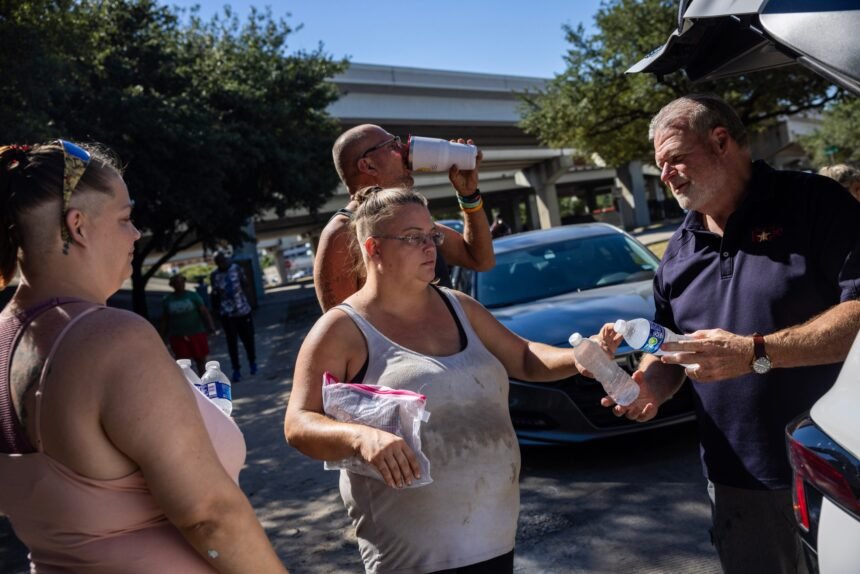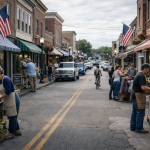As excessive heat warnings loom large in Houston this week, a partnership of community scientists, city and county officials and local groups will fan out across the area measuring temperatures to determine which areas of Harris County are the hottest.
More than 150 volunteers will be roaming the streets of Houston and Harris County on Saturday with thermal sensors strapped to their cars, recording temperatures in the morning, afternoon and evening while on predetermined routes. The data collection, called heat mapping, will guide city and county officials on which neighborhoods need more resources to mitigate severe urban heat and increase tree canopy coverage.
“This research is really heavily and primarily focused on disadvantaged communities, so we’re getting a really good picture of those in Houston that are at the highest risk of heat already.” said Stephanie Piper, research associate in climate and equity at the Houston Advanced Research Center, or HARC. “Then we’re able to address the vulnerability in a more active way.”
This is the second time a large-scale heat mapping campaign is conducted in Houston. The H3at Action Team – led by HARC, the City of Houston, Harris County Public Health, the Student Conservation Center and others – mapped heat severity in 2020. The results highlighted what many experts already predicted: heat is not equal in Houston. In one case, temperatures taken in the afternoon had as much as a 17-degree difference between neighborhoods.
This time, however, the number of routes will be doubled from around 32 in 2020 to 70 this year. The routes also will include a few more affluent communities with more green space, such as Bellaire, to compare with more disadvantaged neighborhoods like Gulfton – which the 2020 effort found to be one of the hottest communities in Harris County.
Cities are particularly susceptible to extreme heat because of the lack of green spaces, impervious cover, such as streets and sidewalks, automobile traffic and industry. Together those factors create what is known as the “urban heat island effect,” which can intensify the heat of a geographic area.
The data also will help HARC determine which areas in Houston are in the most need for tree planting. The Woodlands-based research hub received $15 million in federal funding last September to increase the tree canopy in underserved communities. For the next five years, the grant partners will plant some 50,000 trees around Houston.
“This is kind of one first step for identifying where these hot spots are and where some of the tree planting can happen,” said Piper, who is the project manager for the campaign. “So, we are getting the data and able to mitigate it in the near future.”
Unequal tree coverage
Maria Hernandez has known for years that her Gulfton home is unbearably hot in the summer. She notices the heat while walking down the street, through the community, on sidewalks with no shade and she feels the difference in areas of Houston with more trees and parks.
For nine years, Hernandez, a 57-year-old mother of two and grandmother of four, has worked with Madres del Parque – a Gulfton-area group that began in 2016 to clean up the neighborhood’s limited green spaces, such as Burnett Bayland Park.
“It’s so hot and families would rather travel far away to find a park for their children to cool off than stay here,” Hernandez said. “We need green spaces here with our community.”
Trees are not spread evenly in the Houston area. In West University Place, where the median household income was $190,000 in 2021, trees shade 38 percent of the neighborhood. Just five miles away, trees cover only 6 percent of Gulfton around Benavidez Elementary School, according to the Tree Equity Score – an organization that examines equity and tree canopies across the United States.
A lack of tree coverage leaves certain communities throughout Houston more vulnerable to excessive heat. Green spaces, such as parks and gardens, absorb heat and shade residents from the hot sun.
“Communities that are most impacted by the heat are the ones that have the lowest tree canopy cover and the most amount of concrete and impervious cover,” said Jaime Gonzalez, a Houston-based conservationist. “If there’s not enough nature to keep the neighborhood cool, it can have all of these really bad downstream effects, everything from heat stroke and heat injury to increased crime.”
Implementing nature-based solutions, such as planting more trees or cleaning up a park, is one way to mitigate the urban heat island effect. Members at HARC and other partners can layer heat maps and tree canopy maps to determine which communities need aid, down to specific blocks.
Gonzalez, who is working on contrasting Gulfton and Bellaire, said he should be able to see all the ways one community is cooling down through tree coverage and one mere blocks away is not.
The new dataset, which should be released by November, will be free and available for the public to use. The hope, Piper said, is it will inform community members, city and county officials and organizations applying for local or federal funding to mitigate heat and increase tree cover. It also will help researchers understand how communities are impacted by heat.
For example, the data could show a community is less hot overall, but residents do not have air-conditioning. That can complicate the results, according to Piper.
“Heat can also come from how the built environment is structured. Less shade, darker asphalt, maybe the neighborhood isn’t cooling off at night, huge amounts of traffic,” Piper said. “It really can depend on how people are interacting with the space.”
The data, she hopes, will go into the hands of the community members so they can use it as they see fit.
Hernandez, who finally is seeing positive results after her years of work with Madres del Parque, saw a master plan for Burnett Bayland Park unveiled in July by Harris County Precinct 4. For community members, she said, it is not just adding trees, but maintaining the space and vegetation as well – so it lasts well into the future.
“I’m not a normal grandma in the house knitting or baking cookies,” Hernandez said. “It is possible to make changes and to raise your voice for more parks and less heat.”











